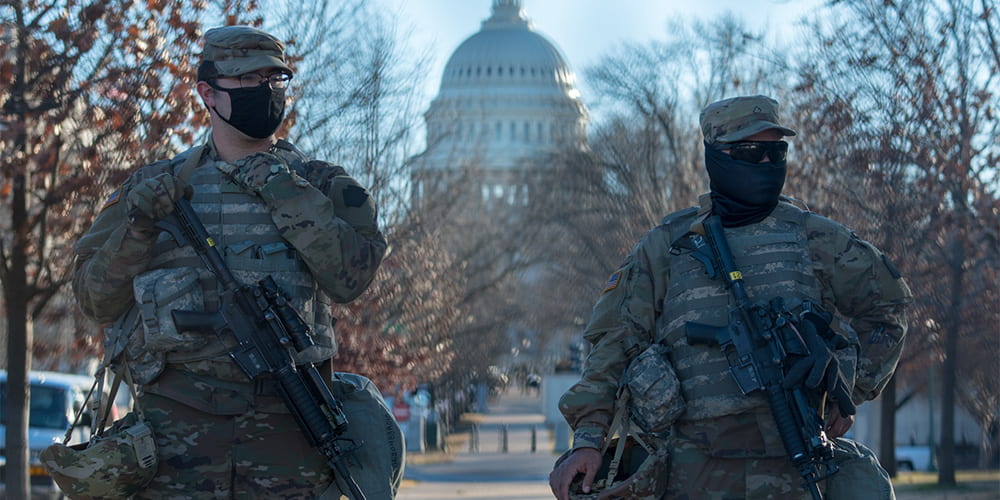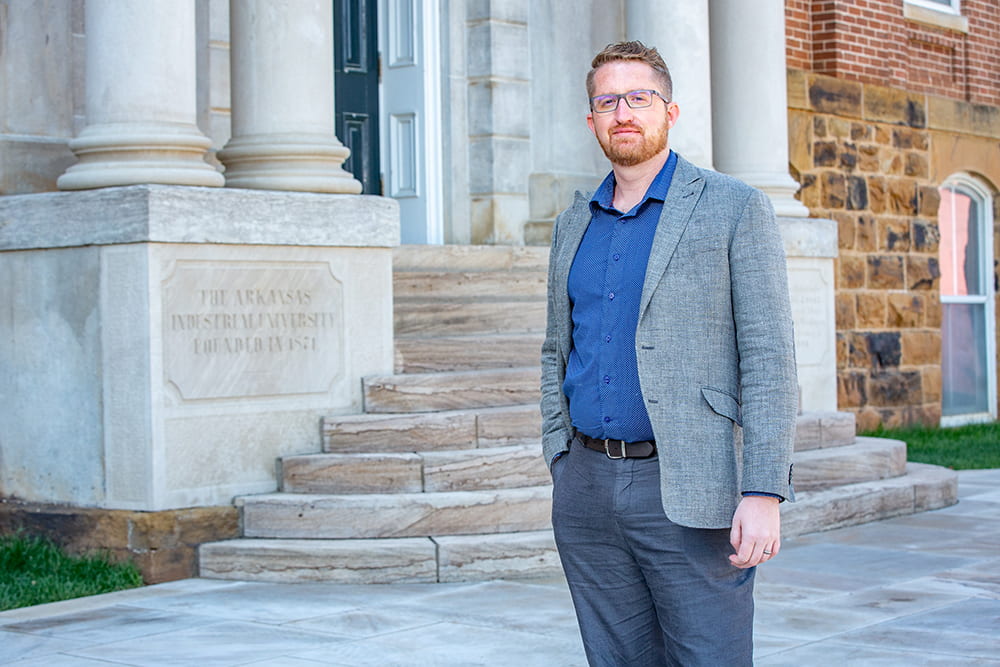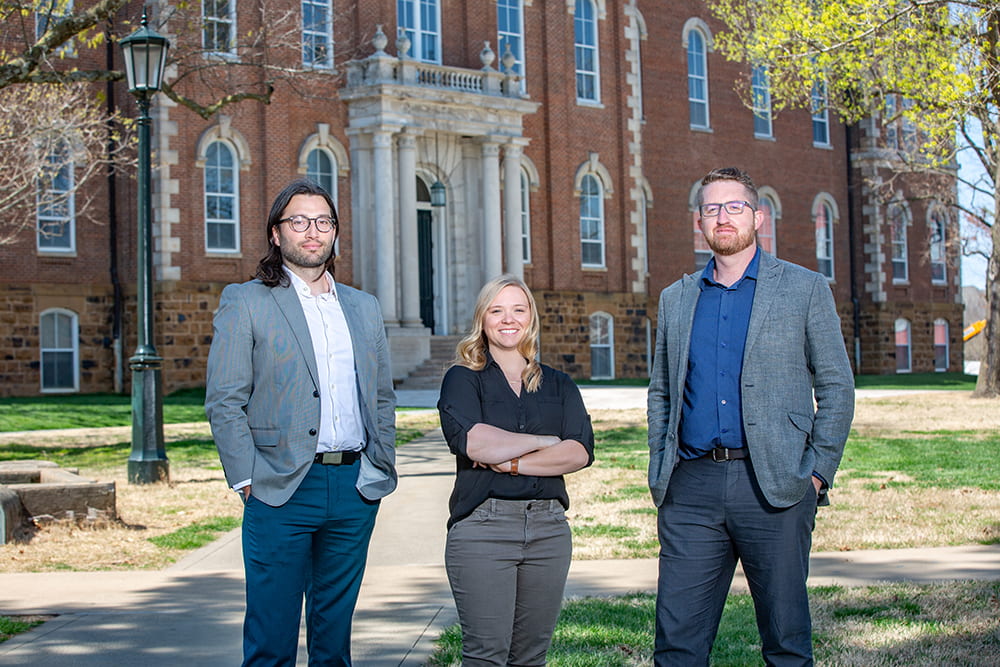Extremist Flashpoints
Terrorism Research Center director shares informed perspective on Capitol attack.

Jeff Gruenewald has a pleasant, agreeable personality, but he isn’t one to smile quickly. He’s serious to the point of solemn, and above all, he is measured; he speaks slowly and chooses his words carefully. He comes across as the kind of person who would write a dissertation on murder, which he did, or direct a terrorism research center, which he does.
Gruenewald is an associate professor in the Department of Sociology and Criminology and director of the Terrorism Research Center in the Fulbright College of Arts and Sciences at the University of Arkansas. The center – currently funded by the Department of Justice – specializes in terrorism and domestic violent extremism ‑ the analysis of demographic patterns of those indicted on terrorism and related charges and emerging groups, court strategies and geospatial and temporal analysis of terrorism and domestic violent extremism.
Gruenewald took the helm of the center in 2019. Starting with his dissertation at Michigan State University in the early 2000s, he has spent his entire professional career, more than 15 years, monitoring and gathering information on people who kill for their ideological beliefs and the victims of these tragic crimes. He has published more 40 peer-reviewed articles on topics related to terrorism and other forms of domestic violent extremism.
As director of the center, one of only a few of its kind in the United States, Gruenewald leads a team of analysts – students, staff and faculty – who conduct and facilitate research on terrorism and domestic violent extremism. Their work not only produces original research but also analyzes the effectiveness of anti-terrorism policies and programs.
The center manages several of the nation’s open-source databases, including the American Terrorism Study, the longest running domestic terrorism project in the country, and the Bias Homicide Database. The American Terrorism Study is a compendium of federal court records and media documents about defendants federally indicted on terrorism-related charges. The Bias Homicide Database tracks bias-motivated murders committed in the U.S. since 1990, including information on the incident, victim and offender.

Jeff Gruenewald, associate professor of sociology and criminology and director of the Terrorism Research Center. Photo by Whit Pruitt.
Gruenewald is also a co-principle investigator of the U.S. Extremist Crime Database. Operated as a collaboration of terrorism researchers from multiple universities, the Extremist Crime Database is a comprehensive source of information on multiple forms of violent extremism in the U.S. since 1990. It contains information on more than 200 extremist murders and is considered the most reliable and robust source for data on the nature and scope of this particular type of violence in the U.S.
Researchers at the center study terrorism and domestic violent extremism across the political spectrum, including radical Islamic terrorism, left-wing terrorism, far-right terrorism, and ecoterrorism.
Before the January 6 riot at the U.S. Capitol, Gruenewald admits, none of this meant much to people outside of criminology and studies on terrorism and homeland security. Since then, however, their knowledge on the topic has been in greater demand.
The events of January 6 will result in a large number of extremist-violence cases for which the Terrorism Research Center will collect relevant federal court documents and other publicly available information. Gruenewald expects researchers at the center to be studying those charged with crimes for the next several years. They’ve already begun to distil the events of that day with their knowledge of domestic terrorism and extremist groups operate.
JANUARY 6: ‘FAILURE OF IMAGINATION’
January 6 started with a Stop the Steal rally near the White House, during which then-president Donald Trump exhorted his supporters to “fight like hell” and march to the Capitol to interrupt or stop Congress’ counting of electoral votes to certify Joseph Biden’s 2020 presidential election win. A group of marchers turned violent beating U.S. Capitol Police officers and tragically killing one before forcing their way into the U.S. Capitol where they defaced and damaged the building and interrupted but ultimately did not prevent the counting of electoral votes.
As Gruenewald is careful to point out, most people who showed up at the Capitol that day were not affiliated with an extremist organization and did not participate in the violence.
But, of those who did, many belonged to organizations that are very familiar to Gruenewald and the center’s researchers, such as the Proud Boys, Oath Keepers, QAnon and more obscure groups such as the Three Percenters and Boogaloo Boys.
Short Talks From the Hill podcast with Jeff Gruenewald.
As federal prosecutors file conspiracy charges against some members of these organizations and as congressional committees meet to discuss security failures that occurred at the Capitol on January 6, investigations have found that members of these extremist groups organized and planned the attack weeks in advance.
Gruenewald has referred to this moment – the point at which loud and dramatic and yet protected-by-the-First-Amendment protest transformed into violent rioting and ultimately criminal behavior – as a flashpoint. Considering his knowledge of these groups, their membership and their propensity for and indeed record of conflict and violence, Gruenewald was not surprised by the turn of events. But it was this feature, the flashpoint, that shocked him just as it did millions of Americans.
“It made sense, even in the moment [that it was a flashpoint],” he says, “but I was still shaken seeing it play out live on TV.”
Two other features surprised Gruenewald as he watched events unfold on television. The scale, he says, was difficult to fathom. His research, as well as that of others, shows that most terrorism and domestic extremist violence and murders happen on a much smaller scale, very often committed by so-called “lone actors,” people who strike out at racial, ethnic and religious minorities or government officials. Seeing that many extremists behaving violently in concert was mind-bending for Gruenewald.
“There was a lot online chatter … that many in law-enforcement were aware of,” Gruenewald says, “but extreme anti-government rhetoric on the internet is not new. Analysts have been studying extremist chatter for decades, and the question is how were they to know this type chatter was any different from that of the past, and why should they think it could manifest into deadly violence against the federal government? So, one of the key questions going forward is, how can they distinguish between benign and more serious online threats?”
All of this largely amounts to another “failure of imagination,” says Gruenewald, borrowing an expression penned in the 9/11 Commission Report following the investigation of the 9/11 attacks. Despite known warning signs, security officials and others who could have taken steps to prevent the January 6 attack from happening could not envision a crowd of protestors would overwhelm police and attack the seat of federal government.
“I imagine we will find instances of critical intelligence that was not widely disseminated and failures to connect the dots leading up to January 6,” says Gruenewald.
THE POWER OF MISINFORMATION, CONSPIRACY AND SOCIAL MEDIA
Extremist violence in the United States is not new. Though the U.S. Extremist Crime Database goes back only to 1990, the roots of domestic extremism can be traced to vigilante groups that formed after the Civil War, most notably the Ku Klux Klan. The intelligence-gathering strengths of law-enforcement combined with poor organization and predictable communication both within and between extremist organizations, they haven’t been that difficult to track. And until now, these organizations were not effective at harnessing mass communication for the purpose of mobilization.

Gruenewald, right, with Grant Drawve, left, assistant professor of sociology and criminology and associate director of the Crime and Security Data Analytics Lab in the Terrorism Research Center; and Katie Ratcliff, associate director and research program manager at the center. Photo by Whit Pruitt.
But this is changing. Today’s threat of extremist violence is different, Gruenewald says. Increased opportunities for online communication, including social media and encryption technology, allow groups to spread misinformation and conspiracies, organize mass events and coordinate training and travel, all of which occurred in the lead-up to January 6.
Gruenewald sees another, and perhaps more disturbing, difference with today’s groups. Bolstered by popular social media outlets and the rhetorical legitimization of misinformation and conspiracy theories by some leaders, current extremism has been “mainstreamed.”
LEARNING FROM THE PAST
“I see what happened at the Capitol as a flashpoint in several ways, one being that it should be used as an event to help us start talking about these dangers,” Gruenewald said.
He has a five-point plan for how to prevent future acts of deadly violence. He doesn’t defer or equivocate on this question. Rather, he is direct and, in one case, as he says, “preachy.”
We must recognize the serious threat of extremist violence, Gruenewald says. By “we,” he isn’t talking about the FBI or law enforcement. He means the broader culture.
“We cannot hesitate to label violence motivated by political and social ideologies as terrorism,” he added.
We have to do a better job of learning from the past and heighten our sensibilities during similarly difficult times, Gruenewald says.
“If the first Black president resulted in increased extreme activity, then we have to expect the first Black and Asian vice-president will do the same. If we know that times of uncertainty lead to more violence, then I think we can expect more violence, given the global pandemic.”
Law enforcement throughout the country, on all levels, must have better training to recognize the signs of radicalization, Gruenewald says. This will take more effort and more funding, as will training the next generation of intelligence analysts, a daunting task that Gruenewald says can best be accomplished by combining the tools of criminology and computer science. He would like to see an investment in more empirical research on the topic of extremist violence, especially examining the links between online and offline radicalization.
Gruenewald says we must educate children about tolerance and empathy for others. This involves teaching children how to listen and incorporating lessons in schools about the threats of misinformation, conspiracies and signs of radicalization encountered online.
“We also need to make sure that we as a society remember that victims of deadly extremism are real people with families grieving for loved ones,” he says. “While these are rare events, they have lasting impacts on our communities.”
Terrorism Research Center
The Terrorism Research Center in the Fulbright College of Arts and Sciences at the University of Arkansas was founded in 2003 by Emeritus Distinguished Professor Brent Smith. Smith, who retired in 2019, is considered a pioneer of criminological research on terrorism in America.
The center conducts research on terrorism, violent extremism and bias crime, and the effectiveness of anti-terrorism policies and programs. In addition to managing several open-source databases, the center trains and equips students with the knowledge and skills they’ll need to help combat terrorism and violent extremism in their future careers.
“We want to get our research into the hands of police and government officials who are working to counter terrorism and violent extremism,” says Jeff Gruenewald, the center’s director. “Many of our graduate students and research interns go on to become intelligence analysts in agencies across the country. We’ve heard many times from previous students that the analytical skills they develop during their time with us are directly applicable to their positions.”
In addition to Gruenewald, the center is led by:
Katie Ratcliff, associate director and research program manager. Ratcliff oversees the day-to-day activities of multiple federal research grants and trains and oversees the work of research interns for the center. She also teaches courses for the Department of Sociology and Criminology.
Grant Drawve, assistant professor in the Department of Sociology and Criminology and associate director of the Crime and Security Data Analytics Lab, which is housed in the Terrorism Research Center. A leading expert in crime analysis, Drawve applies geospatial and risk analysis techniques to the study of terrorism and crime.

Katie Ratcliff. Photo by Whit Pruitt.

Grant Drawve. Photo by Whit Pruitt.

